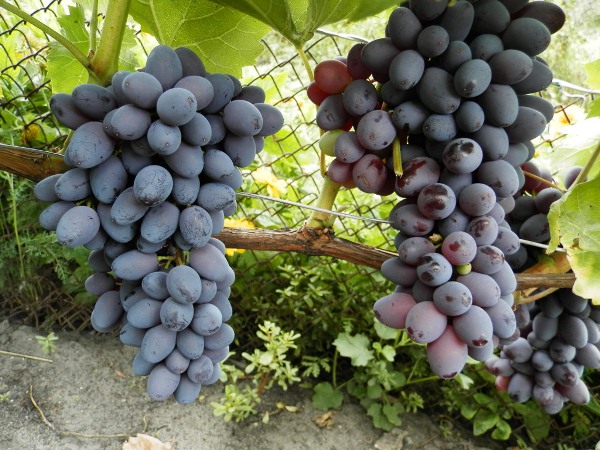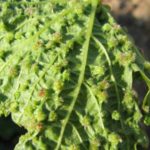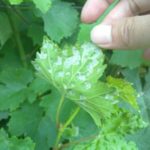Each gardener wants to grow grapes on his plot, which will not only differ in the attractive shape of clusters, good fruit taste, but also do not contain bones. Since a large number of large seeds can significantly spoil the overall impression of the grapes. These varieties include the seedless Jupiter grapes described below.
Table of contents
Biological description of the grape variety Jupiter

One of the most popular and best seedless table grape varieties - Jupiter, which due to frost resistance is the undisputed favorite in temperate latitudes. The grape makers are breeders John R. Clark, James N. Moore from the University of Arkansas USA. To obtain a hybrid, grapes such as V. Vinifera and V. Labrusca were used.
Shrubs of Jupiter with a well-developed root system are characterized by an average growth force. The vine is light brown in color. The plant is decorated with green three-bladed, slightly dissected leaves. Bisexual flowers that do not require additional pollination. Medium density clusters have a shape in the form of a cylinder or a cone and uniform density. Cluster weight varies from 200 before 500 year 3-5 shoots can be tied up on the shoots, so there is no need for rationing, as with proper care the plant can easily cope with the load.Up to 40 holes should be left on the vine.
Characteristics of berries
Oval-shaped berries are located tightly in a hand to each other, so the cluster is compact and accurate. The weight of one fruit is 4-5 g, which is considered high for a raisin. Attention is drawn to the process of ripening berries: in technical maturity, their skin has a red or pink color, which at the time of biological maturation becomes dark blue. This helps to correctly determine the time of harvest.
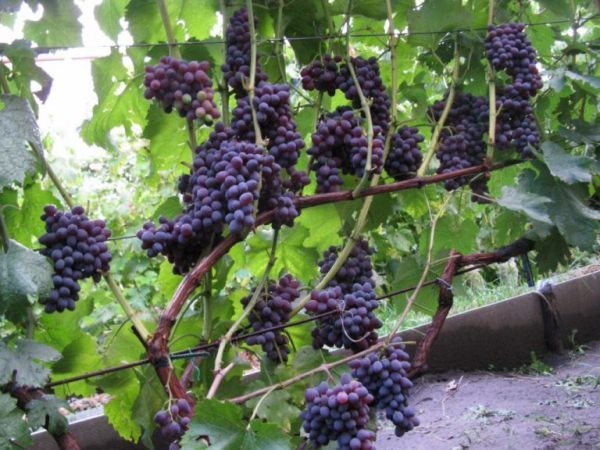
The density of the skin does not give the aspen families to destroy the harvest of tasty fruits. The fruit has no pits, but may contain a small amount of rudiments. Juicy flesh has a fleshy structure, sweet taste with a delicate hint of nutmeg and a medium isabel tone.
The strengths and weaknesses of the raisins
The main advantages for which the variety is recommended for cultivation are:
- early term entry into fruiting;
- high yield indicators 200-250 centners can be produced per hectare;
- the good rooting cuttings and aging of shoots, even in regions with a harsh climate;
- preservation of taste and presentation during transport over long distances;
- frost resistance, the ability to withstand up to -26̊С, in connection with which does not require additional shelter;
- great resistance to cracking berries with sharp fluctuations in temperature and humidity;
- the versatility of the berries, used both fresh and used for the manufacture of homemade wine and high-quality raisins, distinguished by sweetness and long shelf life;
- attractive external characteristics of the vine and berries provide an opportunity to use the vineyard for decorative purposes.
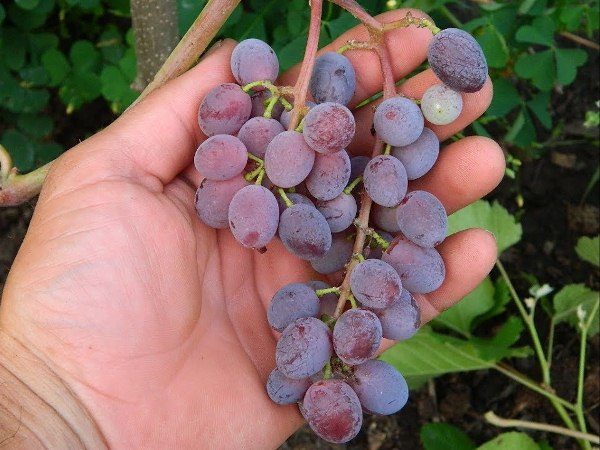
In addition to the advantages, it is important to identify and disadvantages, namely:
- shedding of fruits upon ripening, therefore, it is necessary to monitor the growth process, taking the harvest as soon as the berries acquire a bright blue color and are filled with juice;
- average resistance to mildew, Oidium and gray rot, why bushes need regular treatment to eliminate the loss of crop risk.
Landing technology
Young seedlings better planted in the spring. During the summer season, the plant takes root in the soil and acclimatizes to the external environmental conditions. It is possible to carry out planting in the fall, only to carry out all the measures for the protection of the grape bushes from low temperatures.
The main condition - to correctly determine the location for planting bushes plants. Choosing a site to give preference to the sunlit and protected from the wind areas.
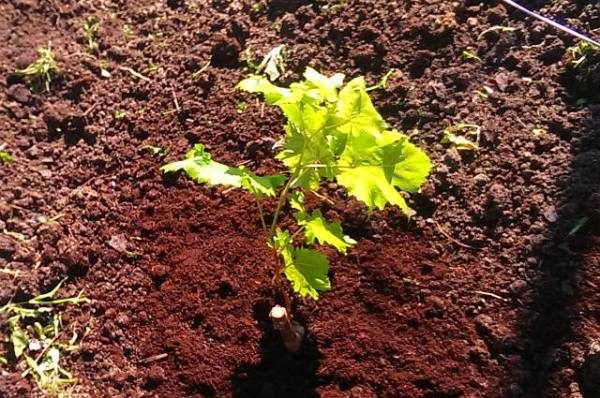
Stages of the landing process:
- Prepare a plot removing all weed vegetation and digging the soil deep.
- 2-3 weeks need prepare the pits observing the distance between them from 2 to 4 m.
- Put crushed stone on the bottom of the hole up to 10 cm top with a mixture of humus and fertile soil and cover the ground, which will separate the roots of seedlings from fertilized layers.
- Insert a peg on the north side, that in the process of growth will serve as a reliable support.
- Before landing put the seedlings in water or solution promoting fast growth and root formation.
- Set a sapling so that the point of divergence of the shoots on the seedling remains at ground level. Fill gently with earth, adding water for greater soil density.
- Then pour on fix pegs and mulch the soil fertilized with nutrients.
Care for a young and mature vine
The grape variety Jupiter is not considered capricious in the care, but for the formation of a high-quality high-quality harvest requires compliance with certain rules of care:
- provide the plant with moisture at the time of bud break, after flowering and during the growth of the fruit, by means of high-quality irrigation, using water at room temperature;
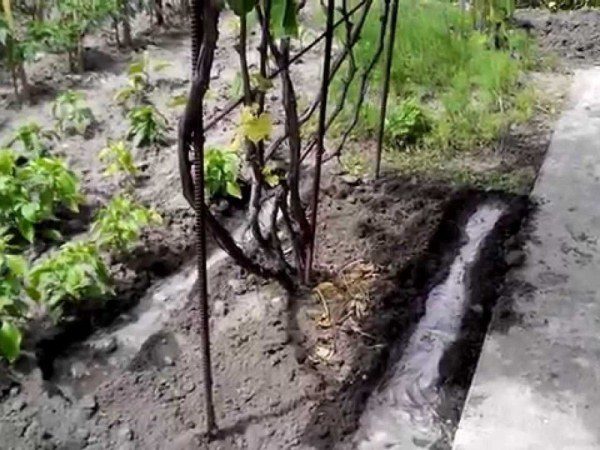
- clear territory plant growth from weeds;
- mulch the earth to preserve the structure of the soil, the proper work of its microflora, retention of moisture and blocking weed crops;
- realize root and foliar feeding essential nutrients;
- prune the vines, shortening shoots by 6-8 buds, which will help stimulate plant growth to increase yields;
- remove weak shoots in spring, so that they do not pull out the plant resource;
- perform green operations, which include debris, pinching growth points and staving;
- spend preventive spraying to prevent the vineyard from being infected with diseases and pest invasion;
- protect young bushes from freezing in winter, by covering them with special materials that let in moisture and air, which will ensure a normal microclimate.
Breeding methods
The plant is well rooted and takes root. Jupiter can be propagated:
Rooted cuttings or grafted seedlings
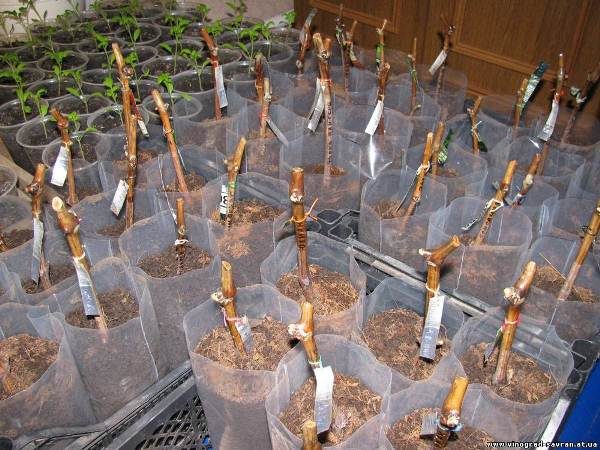
This breeding method is good because bushes completely inherit all the technical characteristics of the variety. And the vaccinated specimens differ in the most powerful force of growth.
With graft stock
According to experienced winegrowers, excellent compatibility with the Jupiter variety. with rootstocks of grapes Kober 5BB, C04 and Berlandieri XRiparia.
Layering from the mother bush
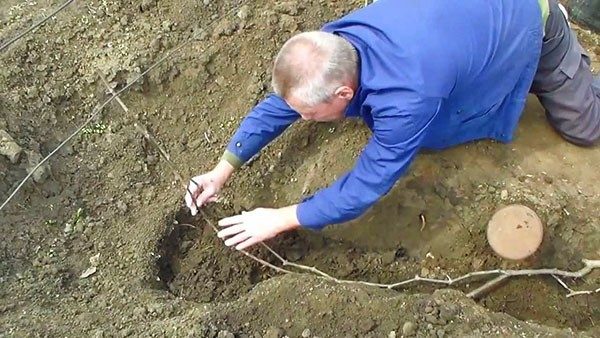
In this case, you need to use fruiting grapevine with strong, well-matured vines, which will serve as a material for breeding grapes.
Diseases and pests
The average resistance of Jupiter to disease. Therefore, oidium and mildew should be constantly fought, that is, regularly treated with special means from fungal diseases. Prevention needs to be started in early spring, when young leaves will form, with an average air temperature of 12̊ C, and continue until the fruit ripens.
The plant can be attacked by many pests, namely grape aphid, weevils, ticks, midges. In order for the vineyard not to become the center of a cluster of dangerous insects, protective procedures must be carried out in time. In the spring and autumn to clean up and burn the fallen leaves. Also inspect the bushes, and in identifying problems to resort to mechanical and chemical methods.
- Grape Aphid
- Weevil - pest of grapes
- Grape flea
- Signs of defeat grapes tick
Grape Jupiter is of particular interest to winegrowers, due to the early term of ripening, attractive appearance of fruits, their harmonious taste, as well as resistance to adverse factors and climatic conditions.
